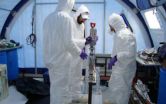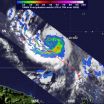(Press-News.org) The causes underlying the development of certain types of common cancers have not yet been elucidated. In order to better determine the origin and the sequence of events responsible for the onset of colon cancer, the teams led by Thanos Halazonetis and Stylianos Antonarakis, professors at the University of Geneva (UNIGE), Switzerland, have sequenced the DNA of biopsied tissue from colon polyps. The results show that these precancerous lesions have a specific profile called 'mutator', which is associated with an increased frequency of acquisition of certain mutations. The study, published December 1, 2012 in the journal Cancer Research, also designates mutations in three specific genes as being the likely initiators of the progression towards malignancy.
At each cell division, the entirety of our DNA, that is some 6.4 billion base pairs, must be replicated. The enzymes engaged in this task work at a prodigious rate of about 1000 base pairs per minute. This sometimes leads to errors, which are usually corrected by other enzymes. However, the repair mechanisms do not work when there is a defect in the DNA replication process, which is the case for cancer cells.
The genome of human cancer cells is generally unstable. The different forms and causes of this characteristic, which results in a greater susceptibility to acquire mutations, are not all known. "In order to explore the genesis and better understand the sequence of events leading to tumor development, we probed the DNA of precancerous lesions," explains Thanos Halazonetis, Professor at the Departments of Molecular Biology and Biochemistry of the UNIGE's Faculty of Science.
To do this, the team led by the professor sequenced the exome, which is the part of DNA that codes for proteins, from colon polyps sampled from patients. The researchers were thus able to pinpoint mutations in three specific genes, constituting the likely initial cause on the road to malignancy. "These genes, named APC, CTNNB1 and BRAF, all have a vital role in the cell. In particular, they are involved in cell division and adhesion to other cells, as well as various intracellular signaling pathways," explains Sergey Nikolaev, at the Department of Genetic Medicine and Development of the Faculty of Medecine, and first author of the article.
The researchers also compared the DNA of polyps, which most were precancerous, to that of healthy colon tissue. They discovered in the former an abnormally high frequency of mutations called SNS, characterized by the substitution of a single DNA base by another. "These precancerous lesions have a profile called 'mutator' which is associated with an increase in the frequency of acquiring SNS type mutations. During early development of the polyp, the mutation rate in these cells is normal, and then it accelerates over time," says Thanos Halazonetis.
The mutation rate observed in polyps was sometimes 200 times greater than that present in normal cells, which greatly increases their progression towards a cancerous stage. According to the professor, these polyps become cancerous in five to ten years. Thanks to these findings, recommendations for routine biopsies, usually conducted every five years, could henceforth be refined on a case to case basis.
### END
Researchers identify a mechanism for the transformation of colon polyps
Researchers from the University of Geneva demonstrate that, in this type of lesion, the rate of progression from a precancerous state to the tumor stage accelerates over time
2012-12-01
ELSE PRESS RELEASES FROM THIS DATE:
Men and women explore the visual world differently
2012-12-01
Everyone knows that men and women tend to hold different views on certain things. However, new research by scientists from the University of Bristol and published in PLoS ONE indicates that this may literally be the case.
Researchers examined where men and women looked while viewing still images from films and pieces of art. They found that while women made fewer eye movements than men, those they did make were longer and to more varied locations.
These differences were largest when viewing images of people. With photos of heterosexual couples, both men and women ...
UI researcher predicts more intense North Atlantic tropical storms
2012-12-01
Tropical storms that make their way into the North Atlantic, and possibly strike the East Coast of the United States, likely will become more intense during the rest of this century.
That's the prediction of one University of Iowa researcher and his colleague as published in an early online release in the prestigious Journal of Climate, the official publication of the American Meteorological Society.
The study is a compilation of results from some of the best available computer models of climate, according to lead author Gabriele Villarini, assistant professor of civil ...
Native Americans and Northern Europeans more closely related than previously thought
2012-12-01
BETHESDA, MD – November 30, 2012 -- Using genetic analyses, scientists have discovered that Northern European populations—including British, Scandinavians, French, and some Eastern Europeans—descend from a mixture of two very different ancestral populations, and one of these populations is related to Native Americans. This discovery helps fill gaps in scientific understanding of both Native American and Northern European ancestry, while providing an explanation for some genetic similarities among what would otherwise seem to be very divergent groups. This research was published ...
Emerging vector-borne diseases create new public health challenges
2012-12-01
West Nile virus, Lyme disease, dengue fever, and plague are examples of "vector-borne zoonotic diseases," caused by pathogens that naturally infect wildlife and are transmitted to humans by vectors such as mosquitoes or ticks.
According to Marm Kilpatrick, who studies the ecology of infectious diseases at the University of California, Santa Cruz, a broad range of human activities can affect the spread of zoonotic diseases. In an article in the December 1 issue of the British medical journal Lancet, Kilpatrick and coauthor Sarah Randolph of the University of Oxford describe ...
Ancient microbes survive beneath the icy surface of Antarctic lake
2012-12-01
Researchers funded by the National Science Foundation (NSF) describe in a new publication a viable community of bacteria that ekes out a living in a dark, salty and subfreezing environment beneath nearly 20 meters of ice in one of Antarctica's most isolated lakes.
The finding could have implications for the discovery of life in other extreme environments, including elsewhere in the solar system.
If, as the researchers postulate, the bacteria survive purely from chemical reactions, as opposed to drawing energy from the sun or other sources, "this gives us an entirely ...
Vitamin D tied to women's cognitive performance
2012-12-01
Two new studies appearing in the Journals of Gerontology Series A: Biological Sciences and Medical Sciences show that vitamin D may be a vital component for the cognitive health of women as they age.
Higher vitamin D dietary intake is associated with a lower risk of developing Alzheimer's disease, according to research conducted by a team led by Cedric Annweiler, MD, PhD, at the Angers University Hospital in France.
Similarly, investigators led by Yelena Slinin, MD, MS, at the VA Medical Center in Minneapolis found that low vitamin D levels among older women are associated ...
Geoscientists cite 'critical need' for basic research to unleash promising energy resources
2012-12-01
Developers of renewable energy and shale gas must overcome fundamental geological and environmental challenges if these promising energy sources are to reach their full potential, according to a trio of leading geoscientists. Their findings will be presented on Dec. 4, at 5:15 p.m. (PT), at the fall meeting of the American Geophysical Union (AGU) in San Francisco in Room 102 of Moscone Center West .
"There is a critical need for scientists to address basic questions that have hindered the development of emerging energy resources, including geothermal, wind, solar and ...
NASA sees 'hot towers' in intensifying Typhoon Bopha
2012-12-01
Bopha intensified into a typhoon today, Nov. 30, as it continues to affect the islands in Micronesia in the western North Pacific Ocean. NASA's TRMM satellite captured rainfall data of Bopha and noticed "Hot Tower" thunderstorms as it was intensifying from a tropical storm into a typhoon.
When NASA and the Japanese Space Agency's Tropical Rainfall Measuring Mission (TRMM) satellite passed over Bopha twice on Nov. 29, and the later data showed that the area of heaviest rainfall had expanded and was still south of the center of circulation. The heaviest rainfall was occurring ...
Emerging vector-borne diseases create new public health challenge
2012-12-01
Human activities are advancing the spread of vector-borne, zoonotic diseases such as West Nile virus, Lyme disease and dengue fever, report scientists publishing a series of papers today in the journal The Lancet.
Vector-borne zoonotic diseases result from disease-causing agents or pathogens that naturally infect wildlife, and are transmitted to humans by carriers such as mosquitoes and ticks. In short, they're diseases transmitted between animals and humans.
Widespread land-use change, globalization of trade and travel, and social upheaval are driving the emergence ...
ORNL develops lignin-based thermoplastic conversion process
2012-12-01
Turning lignin, a plant's structural "glue" and a byproduct of the paper and pulp industry, into something considerably more valuable is driving a research effort headed by Amit Naskar of Oak Ridge National Laboratory.
In a cover article published in Green Chemistry, the research team describes a process that ultimately transforms the lignin byproduct into a thermoplastic – a polymer that becomes pliable above a specific temperature. Researchers accomplished this by reconstructing larger lignin molecules either through a chemical reaction with formaldehyde or by washing ...
LAST 30 PRESS RELEASES:
University of Oklahoma researcher awarded funding to pursue AI-powered material design
Exploring how the visual system recovers following injury
Support for parents with infants at pediatric check-ups leads to better reading and math skills in elementary school
Kids’ behavioral health is a growing share of family health costs
Day & night: Cancer disrupts the brain’s natural rhythm
COVID-19 vaccination significantly reduces risk to pregnant women and baby
The role of vaccination in maternal and perinatal outcomes associated with COVID-19 in pregnancy
Mayo Clinic smartwatch system helps parents shorten and defuse children's severe tantrums early
Behavioral health spending spikes to 40% of all children’s health expenditures, nearly doubling in a decade
Digital cognitive behavioral treatment for generalized anxiety disorder
Expenditures for pediatric behavioral health care over time and estimated family financial burden
Air conditioning in nursing homes and mortality during extreme heat
The Alps to lose a record number of glaciers in the next decade
What makes a good proton conductor?
New science reporting guide published for journalists in Bulgaria
New international study reveals major survival gaps among children with cancer
New science reporting guide published for journalists in Turkey
Scientists develop a smarter mRNA therapy that knows which cells to target
Neuroanatomy-informed brain–machine hybrid intelligence for robust acoustic target detection
Eight SwRI hydrogen projects funded by ENERGYWERX
The Lundquist Institute and its start-up company Vitalex Biosciences Announces Strategic Advancement of Second-Generation fungal Vaccine VXV-01 through Phase 1 Trials under $40 Million Competitive Con
Fine particles in pollution are associated with early signs of autoimmune disease
Review article | Towards a Global Ground-Based Earth Observatory (GGBEO): Leveraging existing systems and networks
Penn and UMich create world’s smallest programmable, autonomous robots
Cleveland researchers launch first major study to address ‘hidden performance killer’ in athletes
To connect across politics, try saying what you oppose
Modulating key interaction prevents virus from entering cells
Project explores barriers to NHS career progression facing international medical graduates
Jeonbuk National University researchers explore the impact of different seasonings on the flavor perception of Doenjang soup
Two Keck Medicine of USC Hospitals named Leapfrog Top Teaching Hospitals
[Press-News.org] Researchers identify a mechanism for the transformation of colon polypsResearchers from the University of Geneva demonstrate that, in this type of lesion, the rate of progression from a precancerous state to the tumor stage accelerates over time



